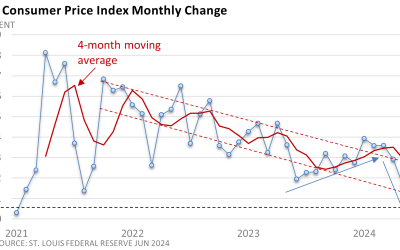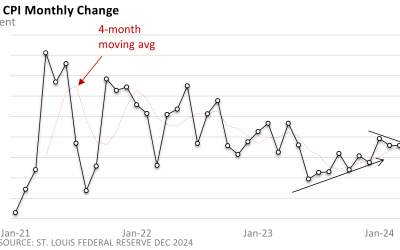
Prosperity Partners Blog
Two Graphs and a Data Table
The labor market is moving back into balance. No longer do we come across articles touting the Great Resignation. In 2021 and 2022, it was ‘advantage employee.’ Employees still have some leverage, but the pendulum has gradually been swinging back to employers. Of course, this varies from industry to industry, but conditions are generally balanced.
Another Soft Inflation Number Bolsters the Case for Lower Rates
In 2021 and 2022, soaring inflation sparked the most aggressive series of rate hikes in decades. While prices remain high, the rate of those price increases has slowed, and the Federal Reserve may finally be seriously considering a reduction in interest rates.
At First Glance, Another Solid Jobs Report
The U.S. Bureau of Labor Statistics (BLS) reported that nonfarm payrolls rose a solid 206,000 in June, topping the consensus forecast offered by Bloomberg News of 190,000. However, first glances may not always leave the correct impression. Private sector payrolls increased by a more modest 136,000, and nonfarm payrolls were revised downward by 111,000 in April and May.
A Dysfunctional Housing Market
What happens when mortgage rates tumble below 3% and then spike above 7%? Unintended consequences are bound to play out. In hindsight, they aren’t difficult to spot. You’re a winner if you have no intention of moving and were lucky enough to lock in ultra-cheap rates just a few years ago. Those who want to move or renters who want to buy are less fortunate.
Mixed Signals
Much has been made of the remarkable resilience of the American economy. Forecasters who confidently called for a recession in 2023 got it wrong. So far this year, the economy is generating new jobs, and the U.S. economy has yet to falter.
A Steady-as-She-Goes Fed and a Tame Inflation Report
As expected, the Federal Reserve announced last Wednesday that it held its key rate, the fed funds rate, unchanged at 5.25 – 5.50%. The Fed left the door open to a cut in rates later in the year if inflation makes meaningful progress toward its 2% annual goal or if there is an unexpected weakening in the labor market.
Strong Jobs Report, with a Caveat
The U.S. Bureau of Labor Statistics reported that nonfarm payrolls in May rose 272,000, easily beating expectations of 190,000 per the Wall Street Journal. Over the past three years, nonfarm payrolls have usually topped expectations. That narrative remains intact.
Housing Prices Hit New Record
The price of a home hit a new record, according to the latest data on housing prices. The S&P CoreLogic Case-Shiller 20-City Home Price Index, which measures monthly housing prices in 20 major metropolitan areas, rose 1.6% on a nonseasonally adjusted basis in March.
Drifting Higher
Stocks have been drifting higher for several weeks as investors search for a catalyst that could drive shares in either direction. Interest rates can influence market direction, but there hasn’t been much news recently on the rate front.
How Do Investors Spell Relief?
Investors celebrated an ‘in line with expectations’ CPI that suggested the rate of inflation isn’t accelerating. It’s a small win, but it was enough to send the three major market indexes, the Dow, the Nasdaq, and the S&P 500 to new highs.
An Annual Ritual at the Gas Pump
You’re right if you have this nagging feeling that gas prices rise in the spring. As the graphic illustrates, on average prices rise through Memorial Day, plateau over the summer, and slip in the fall. This year is no exception, as prices echo the seasonal pattern.
Rate Cuts Still on the Table, Timing Less Certain
We often discuss the Federal Reserve and interest rates because both greatly impact investors. For starters, changes in interest rates have a significant impact on stock prices and income earned on savings. Sharply higher rates in 2022 pushed equities into a bear market.














